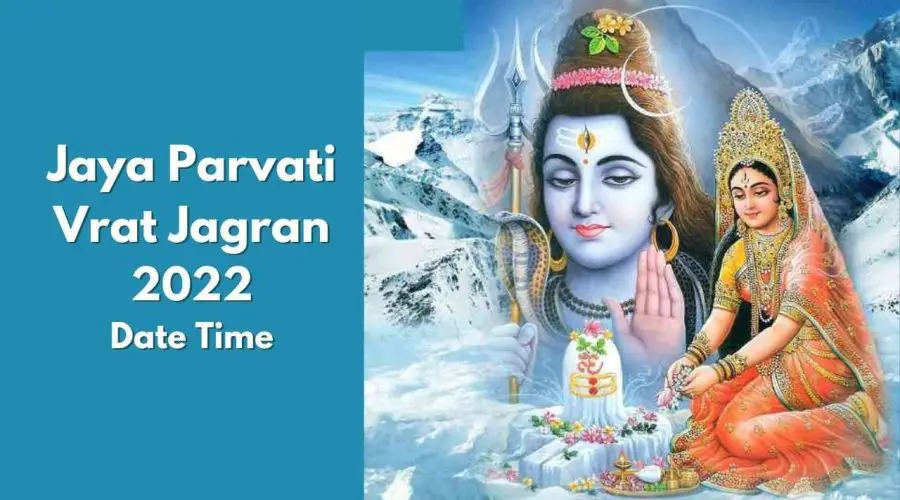Jaya Parvati Vrat Jagran 2022: Date, Time, Rituals and Significance
Article Rating
☆☆☆☆☆ 3.9/5
The Jaya Parvati Vrat is a five-day fast held by married women in Gujarat during the Hindu lunar month of Ashad or Ashara. Jayaparvati Vrat 2022 will take place in the mornings of July 12 and 16, 2022. The date for Jaya Parvati Vrat Jagran 2022 is July 12.
The Vrata is conducted for the family’s well-being, peace, and prosperity, and is dedicated to Lord Shiva and Goddess Parvati. During this time, many Poojas dedicated to Shiva and Parvati, such as the Uma Maheshwar puja, are done.
Jaya Parvati Vrat Date 2022
Tuesday, Jul 12, 2022
Jayaparvati Pradosh Puja Muhurat: 07:29 pm to 09:35 pm
Duration: 02 Hours 07 Mins
Vrat Ends: Saturday, Jul 16, 2022
Trayodashi Tithi Begins: Jul 11, 2022 at 11:13 am
Trayodashi Tithi Ends: Jul 12, 2022 at 07:46 am
Rituals
On the first day of Jaya Parvati Vrat, sow wheat seeds in tiny pots. ‘Jwara’ is the name given to these little pots. Fast for five days and five nights while worshipping these pots. When you finish your fast, you perform this rite every day. After offering water to wheat seeds in Jwara, say a prayer.
The Lord Shiva temple attracts a large number of women who come to worship him. Diya, flowers, incense sticks, kumkum, water, and sweets are offered to Lord Shiva and Goddess Parvati. The pot of Jwara is immersed in a holy river or lake on the next day of Jagran by women or unmarried girls. After visiting the temple, several of them break their fast. They worship to Lord Shiva and Goddess Parvati before eating a big meal to break the fast.
Things To Be Remebered While Keeping Fast
- During the five-day Jaya Parvati Vrat, a partial fast is observed. Most married ladies avoid salt in their food. Wheat and a few veggies are also off-limits.
- Married women who are observing the Vrata keep an all-night vigil or ‘jagran’ on the fifth day of the Vrata. On the next day’s morning, the Vrat is broken by eating wheat and salt-containing foods.
- During the five days of Vrata, salt is completely avoided. Wheat and vegetables are likewise kept to a minimum. During this time, many poojas dedicated to Shiva and Parvati, such as the Uma Maheshwar puja, are done.
- Those participating in the Vrata keep an all-night vigil, or ‘jagran,’ on the fifth day. Jaya Parvati Jagran is the term for staying awake late at night.
- On the final day, the Jaya Parvati Vrat is shattered by eating wheat and salt-based foods.
- It is customary for individuals who observe Jaya Parvati Vrat to do so for five or seven years in a row.
- In Gujarat, unmarried ladies and young girls observe the Gauri Vrat over the same time period.
Significance of Jaya Parvati Vrat
According to Indian mythology, Lord Shiva and Goddess Parvati had a brahmin pair who were tremendous worshippers. Every day, they would worship Lord Shiva and Goddess Parvati. They had everything they wanted in life except a child, so they went to Lord Shiva for help.
Lord Shiva was gratified by their devotion and appeared in their dream. To fulfil their goal, Lord Shiva advised the couple to resurrect the Shivling buried deep in the wilderness and worship the Linga.
Following Lord Shiva’s directions, a couple set out to find the long-forgotten Shivaling in the wilderness. The next day, they ventured deep into the jungle and discovered a run-down location where the couple discovered the Shivaling. While his wife cleaned the place, a husband gathered flowers to gift to Shivaling. After that, she offered puja to the Shivaling.
Meanwhile, her husband was bitten by a deadly snake while picking flowers and was rendered comatose. She prayed to Lord Shiva with great devotion as soon as she learned about the tragedy. After then, Lord Shiva was pleased with her devotion and restored her spouse back to life. The couple was later blessed with a son.
Frequently Asked Questions
1. Who can do Jaya Parvati Vrat?
Unmarried girls and married ladies in Gujarat and other regions of Western India observe the Hindu festival of Jaya Parvati Vrat in Ashada Maas. This vrat is observed for five days every year for five, seven, nine, or maybe eleven years.
2. How is Jayaparvati Vrat celebrated?
Women go to temples and worship for lengthy periods of time, as well as offering Bhog and Flowers to Lord Shiva, Goddess Jaya, and Goddess Parvati. They also chant bhajans and hymns. During the Jayaparvati Vrat, no salt should be ingested in any form.
3. What is the importance of Jaya Parvati Vrat?
The Jaya Parvati Vrat is devoted to God Shiva and Goddess Parvati’s adoration. Women, particularly in Gujarat and western India, conduct this vrat with complete devotion and dedication for their families’ wealth, peace, and welfare.
4. Can we eat fruits during fasting?
Intermittent fasting, like any other eating plan, necessitates the consumption of high-nutrient meals. Vitamins, minerals, phytonutrients (plant nutrients), and fibre are commonly found in fruits and vegetables.

